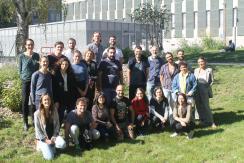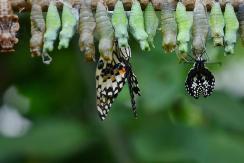COEVOL Multi-Scale Coevolution
Living systems are highly integrated, with a multitude of levels of organization, from molecular and intra-cellular scales to ecosystems. Complex organisms are themselves consortia of macro- and micro-organisms, which work together with their host to build the individual. Yet, each of these organisms can function and evolve in the short term according to its own logic, possibly in conflict with other higher or lower levels, or with other time scales. The once common idea among evolutionists that natural selection results in organisms perfectly adapted to their environment is now severely undermined. Not only because, as the Red Queen explains to Alice, one has to run relentlessly to keep its place in a changing environment, or because past evolutionary history and chance constrain the possibilities of present adaptation, but also because different levels of selection have interests that are generally difficult to reconcile.
Multi-scale coevolution resets classical questions in evolutionary biology
One example, of particular interest is the question of the source of heritable variations. The phenotype of organisms in a population is influenced not only by variations in their nuclear and mitochondrial genomes, the dynamics of which is the object of population genetics, but also more and more patently by the consortium of microbes and genetic elements that constitute its microbiome and virome. The hologenome designates this complex assembly of genetic materials, which obey different rules of transmission and different evolutionary strategies. The ability of symbionts to manipulate host phenotypes or to interfere with each other influences the evolutionary dynamics of all players in ways that are yet poorly understood. In addition, new questions arise, such as the importance of co-adaptation in these systems and their consequences in maintaining cohesive biological systems.
- Symbiosis: a response to and a source of divergent selection
Using a variety of approaches combining experimental evolution, genomic, functional, phenotypic and behavioral data, we aim to test whether symbiosis facilitates diversification and to characterize the underlying microevolutionary processes.
- Ecological networks of horizontal gene transfer
We develop original methods to detect gene transfer and we investigate the factors that influence the routes of gene transfers among microbes but also among insects.
- The interplay between symbiosis, infection and immunity and its evolutionary consequences
We try to understand the intimate interaction of hosts with pathogens, symbionts and transposable elements and how it affects the extended phenotype of the host.
- Transgenerational inheritance and environment changes
We try to decipher the molecular mechanisms that underlie rapid adaptation to environment and to test for transgenerational inheritance of fitness traits.
- Intragenomic conflicts and demography
We are developing models to test whether changes in the demography of the host affect the dynamics of transposable elements.
- The determinism of phenotypic convergence
We study the genomic basis of convergent phenotypic evolution in particular in the case of animals and plants adaptation to increasing temperature and decreasing water.
- Reconciling the tree of life
We develop phylogenetic methods for “reconciling” gene/species or host/symbiont histories and use these methods to explore the bulk of extinct or undescribed species and the history of association of symbiotic microbes with their hosts.
Integrating methods
The methods we use to tackle the questions raised by multi-scale co-evolution extend from theory, modelling and simulation to big data analysis, lab (notably on insects), and to a lesser extent, field activities.
Implication of research, responsibility of researchers and citizen sciences
From our research (some of which have immediate consequences in health, agriculture and ecology) and our concerns about the responsibility of scientists in society, we are committed to promote an “implicative” research. The implicative position means that we try to work on the link between science and society, not only through a one-way communication, applying or explaining our science, but also favoring early discussions on research projects, that may influence our research directions.
Publications
Display of 391 to 420 publications on 706 in total
Long PCR : A sensitive PCR protocol for amplification of Wolbachia endosymbiont in Indian honey bees
Journal of Entomological Research . 36 : 119--122
Journal article
see the publicationMechanisms and Evolutionary Patterns of Mammalian and Avian Dosage Compensation
PLoS Biology . 10 ( 5 ) : e1001328
Journal article
see the publicationNew national and regional bryophyte records, 31
Journal of Bryology . 34 ( 2 ) : 123-134
Journal article
see the publicationLevel of protection and testing scheme
Escort 3: Linking non-target Arthropod testing and risk assessment with protection goals . : 16-24
Book chapter
see the publicationPhylogenetic modeling of lateral gene transfer reconstructs the pattern and relative timing of speciations.
Proceedings of the National Academy of Sciences of the United States of America . 109 ( 43 ) : 17513-17518
Journal article
see the publicationA snapshot of histone modifications within transposable elements in Drosophila wild type strains.
PLoS ONE . 7 ( 9 ) : 1-7
Journal article
see the publicationAn inherited virus influences the coexistence of parasitoid species through behaviour manipulation.
Ecology Letters . 15 ( 6 ) : 603-10
Journal article
see the publicationInfluence of the virus LbFV and of Wolbachia in a host-parasitoid interaction.
PLoS ONE . 7 ( 4 ) : 1-10
Journal article
see the publicationHeritable variation in an extended phenotype: the case of a parasitoid manipulated by a virus.
Journal of Evolutionary Biology . 25 ( 1 ) : 54-65
Journal article
see the publicationAn inherited Virus manipulating the behavior of its parasitoid host : epidemiology and evolutionary consequences
Parasitoid Viruses. Symbionts and Pathogens . 978-0-12-384858-1 : 203-214
Book chapter
see the publicationPopulation genetic structure and secondary endosymbionts of Q Bemisia tabaci (Hemiptera: Aleyrodidae) from Greece
Bulletin of Entomological Research . 102 : 353-365
Journal article
see the publicationA comparative analysis of the amounts and dynamics of transposable elements in natural populations of Drosophila melanogaster and Drosophila simulans.
Journal of Environmental Radioactivity . 113 : 83-86
Journal article
see the publicationLes transferts horizontaux de gènes et l’arbre de la vie
Médecine/Sciences . 28 ( 8-9 ) : 695 - 698
Journal article
see the publicationModeling Gene Family Evolution and Reconciling Phylogenetic Discord
Methods in Molecular Biology . 856 : 29-51
Journal article
see the publicationPreserving Inversion Phylogeny Reconstruction
WABI 2012 - 12th International Workshop on Algorithms in Bioinformatics . : 1-13
Conference paper
see the publicationModulation of Symbiont Lipid A Signaling by Host Alkaline Phosphatases in the Squid-Vibrio Symbiosis
mBio . 3 ( 3 )
Journal article
see the publicationPhylo-MCOA: a fast and efficient method to detect outlier genes and species in phylogenomics using multiple co-inertia analysis
Molecular Biology and Evolution . 29 ( 6 ) : 1587--1598
Journal article
see the publicationAccurate Estimation of Substitution Rates with Neighbor-Dependent Models in a Phylogenetic Context
Systematic Biology . 61 ( 3 ) : 510-521
Journal article
see the publicationEffects of deltamethrin on the specific discrimination of sex pheromones in two sympatric Trichogramma species
Ecotoxicology and Environmental Safety . 84 : 32--38
Journal article
see the publicationComplete Genome Sequence of "Candidatus Portiera aleyrodidarum" BT-QVLC, an Obligate Symbiont That Supplies Amino Acids and Carotenoids to Bemisia tabaci.
Journal of Bacteriology . 194 ( 23 ) : 6654-6655
DOI: 10.1128/JB.01793-12
Journal article
see the publicationEvolution and control of host-microbe symbiosis in arthropods: an RNAseq-based transcriptomic analysis
7. International Wolbachia conference . 978-2-911320-44-6
Conference paper
see the publicationMaking (good) use of Wolbachia: what the models say.
Current Opinion in Microbiology . 15 ( 3 ) : 263-8
Journal article
see the publicationFast and robust characterization of time-heterogeneous sequence evolutionary processes using substitution mapping.
PLoS ONE . 7 ( 3 ) : e33852
Journal article
see the publicationWhat genomes have to say about the evolution of the Earth
Gondwana Research . 21 : 483-494
Journal article
see the publicationEfficient selection of branch-specific models of sequence evolution.
Molecular Biology and Evolution . 29 ( 7 ) : 1861-1874
Journal article
see the publicationA Phylogenomic Approach to Vertebrate Phylogeny Supports a Turtle-Archosaur Affinity and a Possible Paraphyletic Lissamphibia
PLoS ONE . 7 : e48990
Journal article
see the publicationEvidence of diversity and recombination in Arsenophonus symbionts of the Bemisia tabaci species complex
BMC Microbiology . 12(Suppl 1) : 1-15
Journal article
see the publicationtirant, a newly discovered active endogenous retrovirus in Drosophila simulans.
Journal of Virology . 86 ( 7 ) : 3675-3681
DOI: 10.1128/JVI.07146-11
Journal article
see the publicationEfficient Prediction of Co-Complexed Proteins Based on Coevolution
PLoS ONE . 7 ( 11 ) : 1-13
Journal article
see the publicationLinkage to the mating-type locus across the genus microbotryum: insights into nonrecombining chromosomes
Evolution - International Journal of Organic Evolution . 66 ( 11 ) : 3519-3533
Journal article
see the publication

